Rivetts
Posted: Thursday 04th June 2020
Rivetts of Leytonstone Ltd, situated at 234/6/8 High Road Leytonstone, E11, had been, according to the advert on the right, established over 60 years up to 1952. If this is so then they must have been around since c1898. For much of this time Rivetts were selling motorcycles although in the 1890s they manufactured cycles.
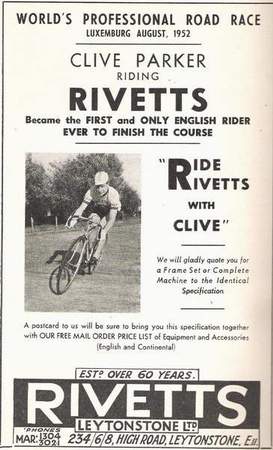
The history of the company is quite hard to get hold of and for this page we are interested in the post-war (WW II) period. For a complete history of Alf Rivett see the article by D E Twitchett below. In 1946 Phil Ingrams, a committed cyclist, opened up the cycle side of the business for Rivetts. He had been a member of Comet CC which became Lea Valley CC. Being personally interested in Continental builders he imported Urago, C N C and Frejus frames. Phil went on to be one of the founder members of the London League which eventally joined up with other sections to become the BLRC. Eventually Phil felt that he was getting nowhere in the business, partly due to three vicious winters which drastically affected sales, so in 1949 he left Rivetts. Phil was an Independent Rider for Dayton cycles for a spell. When he left Rivetts Slasher Beales took over running the business and eventually started to manufacture frames under the name Rivetts. Phil thinks that they were built in the rear of the large workshop using the ‘open-hearth’ process.
I have heard that during the early fifties several independent riders in the BLRC wanted to turn full-professional, which would entail them riding track as well as road. Some of them didn’t feel they had the track experience to play the role of professional track rider. In 1952 the dreaded enemies of the BLRC, i.e. the NCU, set up a track racing school for professionals at Herne Hill track which was run by Johnny Dennis. Two of the participating riders, Clive Parker and Dennis Talbot were sponsored by Rivetts, who supplied them with track and road machines. They did the track riding on Saturdays and road-raced on Sundays. At the end of the one-year course Clive and Dennis plus Derek Buttle and Dave Bedwell were to join Hercules as professional riders.
Some people tend to look down on Rivetts but we have a very well built road frame (believed 1952) constructed from Reynolds 531 tubing using Nervex Professional lugs of the earlier pattern. They were well crafted frames but maybe with not quite the lug filing and detail as classics such as Ephgrave. When the frame returns from restoration we will post details on this page. In the meantime there is an image of the head, pre-restoration below left.
Neil Palmer, a mechanic to teams, including Rivetts, at this time thinks that they closed down the cycle side in the mid-fifties but it may be that, along with many other concerns, they drifted into mopeds and motor-cycles. Even the riders weekly bible Cycling became Cycling and Mopeds for a year or so.
Rivetts on the net, I was manager for 3½ years til June ’62 when Langman the governor cleared out the bikes to make way for camping.
Rivetts head and fork crown pre-restoration.
Nervex ‘early’ Professional lugs and fork crown – not many builders used this fork crown for some reason, maybe price.
Has ‘Slasher Beales’ ground off the rim top and bottom of the lugs or was the rim only on the later version?
This frame number 15201 is believed to be 1952 – could it be one of the frames built for their professionals? Enquiries continue.
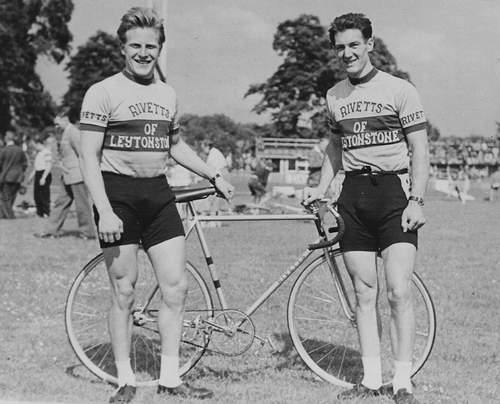
Dennis (Slasher) Beales was my Grandad. He died on the 20th of July 2005, aged 84.
Slash was a member of Comet CC, which amalgamated in 1969 with Crescent Wheelers and is now named Lea Valley Cycling Club. His ashes were buried last summer at Lea Valley CC’s bungalow in Burton End.
I have read your reminiscences of my dad and just loved them. There is a part where you mention going for an uncomfortable ride in someones car, his name was Eric Cursey, he worked at Rivetts too. I know he lives in Barking.
My dad was always tinkering about in the shed at the bottom of our garden in Carr Road. One night he was in the shed as usual messing around with something or another when the front doorbell rang. He answered the door and stood their chatting away as he always did. Eventually the conversation finished and he returned to the shed, lit his fag, and blew the whole shed up. He had just turned on the gas tap before the doorbell went and forgot to turn it off. He woke most of the neighbours up at gone 1 in the morning and sported singed eyebrows for a while. Well that’s my dad, I miss him, but am so proud he is on the internet 2 years after his death and his memory will go on forever. My wonderful dad…..
Read more – Terry Drury reminisces on working as a frame builder at Rivetts in the 50’s.


EARLY LIFE
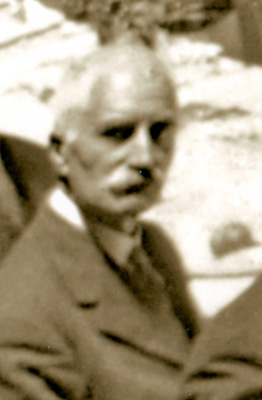
Alf was born in December 1870 , one of five brothers and two sisters born to William James Rivett a builder, (who would later employ ten men) and wife Clara. The family were then living at No 4 Manby Grove, a turning off The Grove at Stratford, employing a live-in nurse and housekeeper. By 1881 the family had moved to No 97 Chobham Road still technically in Stratford New Town but a turning off the Leytonstone Road. Alf then eleven years old is described as a scholar as would be expected.
We next find Alf described as a nineteen year old fitter on the German vessel SS Waesland (built in Glasgow, working for the Red Star Line which was a joint Belgian – American venture – F O) en route from Antwerp to New York where he landed on the 13th July 1888. The passenger list describes him as a “permanent settler.” Whether he had his bicycle with him is not known, but it is recorded in “The first Hundred Years of The Shaftesbury Cycling Club” that he had some success in track racing in California. Dick Swann in an Essex Countryside article of November 1976 records that he was champion of San Francisco but does not quote his source for that information, and I have to record that over the years I have not found Swann reliable as a historian. For example he states in that same Essex Countryside article that Alf was American but in fact he was born to English parents in Stratford East London.
Unfortunately I have not been able to locate details of Alf’s Californian racing career despite enlisting the aid of some American researchers. Late in 1890 Alf left San Francisco by ship to Panama where he undertook the four hour train journey across the isthmus to Colon in Columbia. There he embarked on the steamer Newport which sailed regularly from Colon to New York and back as a regular service in those pre-canal days. Alf landed in New York on the 4th December 1890. I have not been able to locate him on a passenger list for the return journey from New York to the UK so maybe he worked his passage as a fitter. Alf did not return to the family home which was getting crowded with siblings but is seen in the 1891 census boarding, along with brother James at 44 Station Road Forest Gate.
RACING and CLUB DAYS
Once back in England Alf settled whole heartedly into the cycling scene and club life with the Shaftesbury C.C.. The Shaftesbury history quoted earlier records him joining in 1889 but as we have seen he was still very much in America at that date.. That same history records that upon his return he became club champion straight away in 1890. Again that seems unlikely as he could not have left New York before December that year when the season was long over. He would remain club champion for another six years. I quote from that same club history:-
He immediately became the inspiration and idol of the members and remained
so for many years. In 1890 he named the club’s colours cardinal and black. He
was a fine entertainer, and with his banjo was a star turn at all concerts.
It seems that Alf’s success in closed club events was not repeated in open events. From time to time he appears on start sheets but normally without success. For example: on Diamond Jubilee day at the opening of Canning Town Track he rode the five mile open invitation race but was unplaced. I could quote a few more such instances but suffice it to say that though keen and popular locally he was not prominent nationally. That may have been due to his burgeoning business commitments. However a couple of local wins are worth recording. On the 6th of May 1891 a new track was opened at High Beech behind The King’s Oak Hotel. The Essex Cycling Union held an open race meeting there on the following July 8th . One of the events was a one-mile handicap for riders on the old high bicycles just then entering into obsolescence. First was Alf Rivett from scratch. He won by twelve yards in 3 mins 12 and 1/5th seconds. Second man was H. W.Shanty off 80 yards and third Alf’s brother J. Rivett off 40 yards. All three were Shaftesbury C.C, members.
A few years later in May 1896 Alf won The Gumprecht cup at High Beech. Gumprecht was the proprietor of The King’s Oak: a large pub set in a remote part of Epping Forest where there was very little habitation so very few customers. It was built in the belief that the Central Railway would end at High Beech but in fact it stopped at Loughton, leaving the King’s Oak stranded. So in an endeavour to find custom he built the track and promoted events to bring the crowds. The track was also hired out to Cycling and Athletics clubs for training purposes. The track would later be augmented by a splendid ballroom containing a huge pipe organ to provide the dance music and a lido. He provided the Gumprecht cup for the winner of a ten mile scratch race on the track. The heats were held one Saturday and the final the following week so as to maximise the gate money!!! The magazine Cycling reported the final thus:-
The heats had reduced the field to ten riders of whom G. Allen
of the Paddington C.C. did not start. Gidney (the holder) soon
went to the front with Rivett Saftesbury C.C close behind and
Bishop in third position. At four laps from home a pacing
tandem which had been saving itself, came out ant took Rivett
away with a rush, and he thereby gained a 50 yards lead.
Gidney was unable to respond to any extent, and Rivett’s
superior sprinting powers placed him a winner by thirty yards.
Time 26 minutes 58seconds.
Alf’s euphoria was short lived. He proudly displayed the cup in his shop window from where it promptly disappeared. The January 2nd 1897 issue of Cycling reported the cup to have been stolen from the premises of the current holder A. Rivett at Leytonstone Road, Stratford. “A reward has been offered for its recovery”.
MARRIAGE and BUSINESS
Late in 1892 Alf married Louisa Sharp in West Ham but well before that he had started to manufacture bicycles. Sometime in the early 1890s. after his return from America he rented and converted a stable attached to the first house in Ranelagh Road, a turning off Leytonstone High Road. The building can still be seen today. (car tyres when last I looked). There he assembled machines from sets of BSA fittings, and called them BLIZZARDS and designed a distinctive and easily recognized head badge. This consisted of two silver plated strips of copper suitably engraved.. These would eventually be useful for a slogan for “The Blizzard” was advertised as “The Cycle with the Two White Bands.” It was a feature which would make his machines easily recognisable on the road or the track and a boon to future historians when viewing old photographs!! There is never any doubt about the identity of a Blizzard.
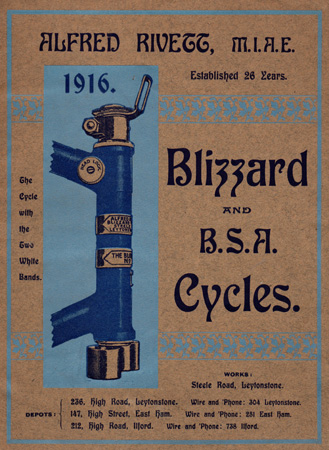
Moving on: in 1901 we find Alf, wife Louisa and seven year old daughter May together with domestic servant Emma living over the shop at no 252 Leytonstone Road Stratford close to Maryland Point: the same premises from which the Gumprecht Cup was stolen in 1897. However in 1904 some new shops were built along the Leytonstone High Road and Alf acquired one and moved his retailing there at no.236. Those premises were very convenient at the time for no.236 was a corner shop, with frontage to both the High Road and to Steele Road. A glance at the map will shew Steele Road to be the next turning to Ranelagh Road where he was building his machines.
The workshop was promptly moved to the back of the new High street premises and accessed from Steele Road which enable Alf to advertise the workshop with a different address to the shop-a bit of kidology which made the business appear larger than it actually was! The fact that a Rivett business still occupies the site today suggests that Alf bought the freehold for businesses usually move for one of two reasons: rent hikes by landlords or else expansion. From the foregoing it can be deduced that any of his machines bearing the Ranelagh Road address on the headbadge will be 1904 or earlier. Those carrying The Steele Road address will date thereafter.
EXPANSION
There is evidence of expansion even before the move to Leytonstone High Road,. The Kelly’s Directory for 1902 records him trading from 5 Ilford Market, High Road, Ilford. That branch remained until 1906 before moving to 212 High Road where it would remain until Alf retired in 1922. Other branches to appear in the early part of the new century would be at 668 High Road Leyton in 1908 (not to be confused with High Road Leytonstone) and at 147 High Street East Ham .in 1902. The East Ham branch also survived until Alf retired but the Leyton branch is not seen after 1914. We can conjecture that the great war was the reason for that- possibly because the staff volunteered or were conscripted and Alf merged the two businesses or possibly because the powers that be decreed that Alf could not have two closely sited shops exempt on the grounds of “essential services”.
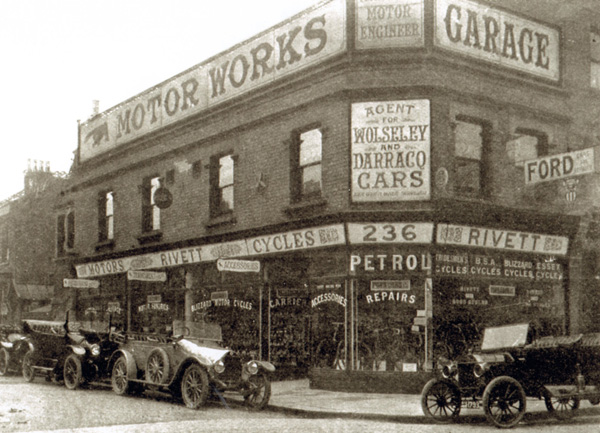
Today it seems unlikely that a cycle shop would be an” essential business” but in 1914 England was a different place and bicycles were necessary to the economy. I can personally recall hundreds of bicycles being ridden daily to the docks by essential workers. even after 1945. Alf does not have a war record so we can only assume that this fit racing cyclist was exempt from call-up.. It is not hard to see why. In 1914 his business had the maintenance contracts for the bicycles belonging to following organisations, proof if any were needed that bicycles were important to the economy.
The General Post Office
West Ham Corporation
East Ham Corporation
Leyton District Council
Ilford District Council
Lea Bridge Gas Company.
The Gas-Light & Coke Co.
Alf took an interest in motor vehicles from their earliest days. He rode an 1898 14hp De-Dion motor-tricycle before April 15th 1900 which fact qualified him for membership of the RAC’s Fellowship of Nineteenth Century Motorists. The date of 15th April 1900 was auspicious, marking the conclusion of the 1000 Miles Trial. Alf’s membership was accepted on November 24th 1927, probably on The Fellowship’s inception. He also appears to have been a member of The Fellowship of Old Time Cyclists: an organisation formalised in 1916. A condition of membership was to have ridden the old high bicycle or tricycle before 1900. Fortunately Alf was in the front row of a photograph taken at the FOTC 1926 annual dinner at The Hotel Cecil. It is the only photograph I have seen of him. His grandson did not have a photo or even a memory image of Alf, who he rarely saw.
LATER YEARS
At the time of the commencement of the first world war, Alf, a successful and popular businessman was no longer living above the shop. In 1911 we find him living with wife Louie and daughters Mary, Dorothy and Kathleen at No 47 Borthwick Road Stratford-yet another turning off The Leytonstone High Road -a short distance from the shop.
After the war Alf began to think of retirement and downsizing the business. In 1917 he moved into “The Chalet” at No 41. Draycott Road, Wanstead, where a carved brick inserted into the wall suggests that the house was designed or built by “K.R” for him It was very conveniently situated close to The Wanstead Golf Club where Alf was now spending much of his leisure time.” The Chalet “ was and still is a substantial property, the entrance hall and staircase being quite Baronial!!!
It was around the same period that Alf set about downsizing the business to enable retirement. In 1922, possibly a year or so earlier, the East Ham branch was acquired by Reynolds who already owned a motor showroom further down East Ham High Street North. The business expanded into Reynolds Motors, well known Ford factors until relatively recent times.. In 1922 the name above the Ilford branch was changed from Rivett to Cave. William Thomas Cave, who was Alf’s manager there, quickly expanded the business. From the single shop at no 212 High Road in 1922, Cave, by 1929, also occupied Nos. 208,210 and 220. These motor showrooms remained for many years after the second world war and closed relatively recently- well within the Author’s memory.
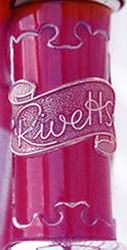
The Leytonstone premises were retained by Alf until 1932 when he sold to the Langman family and retired completely. That was a signal for gradual change. Small shop bicycle manufacture was moving forward. In the mid and later 1930s the sets of fittings by such firms as BSA and Chater Lea were relics that had hardly changed from their 19th century origins. New improved tubing was available from such firms as Reynolds and Accles and Pollock and lugwork with artistic merit was demanded by discerning club cyclists. Alluminium alloy components imported from the continent were also much in demand.
The handbuilt lightweights of the 1930s- 1960s, at their highest level, transcended simple engineering to become works of art. The combined skills of framebuilders, lug-filers, enamellers and chromium platers produced frames of unsurpassed quality and beauty. They are very much sought after today and have been renamed “Classic Bikes” by enthusiastic collectors. Langman’s Rivett frames were part of that revolution, albeit not right at the top. The two white bands on the headtubes were abandoned in favour of a simpler metal badge (image left) which in turn degenerated into a transfer after a few years. In the late 1940s and early 50s Langman promoted the machines by funding a small professional team of racing cyclists on both road and track. However by the early 1960s Langman’s Rivett bicycles were no more. The firm withdrew from bicycle manufacture and retailing completely and concentrated their efforts entirely on motor-cycles and motor cycle clothing.
When, in the early 1960s I obtained my first antique Rivett machine I called into the shop to glean what information I could on the early days of the business. The younger Mr Langman was most helpful and donated me a 1916 catalogue and also trusted me with the loan of his only remaining 1914 version so that I could take some copies of photographs therein and copy details relevant to my early machine. At the time I asked him why it was that he had abandoned bicycles altogether. His reply surprised me.” I was fed up with losing all my customers once they reached eighteen years of age and were conscripted to National Service!!- They never came back after discharge having in the meantime acquired different interests- one of which was motorcycling!.” Mr Langman was wise. He may or may not have been the first to abandon the cycle business but he was certainly not the last. The loss of his in-house frame builder may have also influenced his decision.
In the mid to late 1960s the economy was such that many ordinary working people could suddenly afford small cars: a privilege denied them pre and post war. The advent of affordable motoring combined with National Service conscription hoovering up the nation’s young men was a double blow to the cycle industry which then entered the blackest decades the sport and pastime had seen since the introduction of the primitive boneshakers of 1869. Many old established cycling clubs folded; many traders went bust or just gave up; and all of those cafes around the country which survived entirely on cyclists’ custom closed. The sixties and seventies were indeed dark days for cycling
In later years the business was sold on by The Langmans and at one point the sale of motorcycles was also discontinued, the firm then devoting all their attention to motor-cycle clothing. In that form the business expanded again with several branches around the country; today still carrying the name Rivett.
THE LAST DAYS OF ALF.
In his later years and in retirement Golf was Alf’s main interest. In 1917 he had moved into his new house “The Chalet” in Draycott Rd .- a stones throw from Wanstead Golf club and course. This enabled him to practise regularly and he would be very familiar with the intricacies of every hole. His greatest achievement came in 1924 when he won the Armitage Cup. That was a prestigious trophy and one had to be a very good golfer to gain entry to the event. At the time of Alf’s win the club’s professional was Percy Allis, father of the renowned Peter Allis and his connections would have ensured a top class entry.
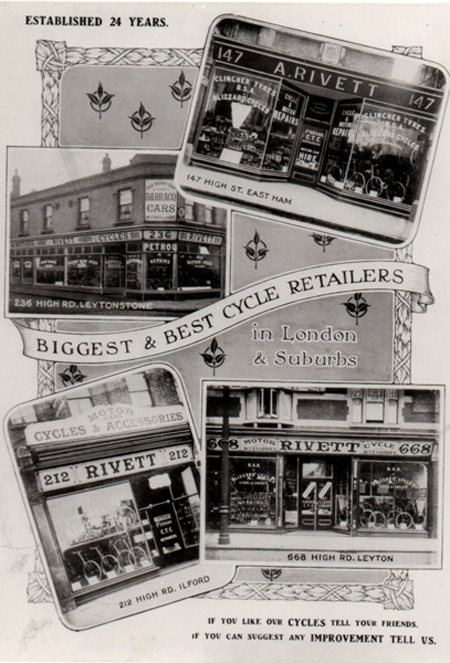
Alf died at home in 1939, four years after wife Louisa., leaving £47,245 gross and £41,723 nett. His will and codicils shew him to have been generous to his maids and gardener, and to his barber who received £25 with the request that it be spent on a holiday or holidays!!! Other bequests benefited The Cycle and Motor Trades Benevolent Fund, and the Royal Infant Orphanage of Wanstead, and in a codicil, £500 to the Connaught Hospital at Walthamstow. The balance was divided between his three daughters. Both the Caves and Reynolds, purchasers of the Ilford and East Ham branches attended the funeral along with family members, staff and Wanstead Golf Club representatives.
The German vessel SS Waesland referred to above was built in Glasgow, working for the Red Star Line which was a joint Belgian – American venture, and not German.
Rivetts isn’t very far from the former family home of the poet Gerard Manley Hopkins in the Grove Stratford who wrote the famous poem The Wreck of the Deutschland c 1875, several of whose victims are buried in St Patrick’s Cemetery in Leytonstone. [a decade earlier than when Alf was sailing] The ship was another emigrant liner, though obviously German!
Posted: Thursday 04th June 2020
Contents
- Rivetts of Leytonstone Ltd
- History of the company
- Reynolds 531 tubing
- Terry Lack
- Rivetts track frame
- Robert Roue
- Dennis's daughter Gilly
- Rivetts down tube
- Alf Rivett
- About Alf Rivett
- Racing and club days
- Gumprecht cup
- Alf’s euphoria
- Marriage and Business
- Blizzard 20 page quarto catalogue 1916
- Expansion
- Leytonstone shop
- Essential business
- Alf
- Later years
- The Langman years
- The last days of Alf
- Alf
- Felic Ormerod
This article appears in the following categories.
Upcoming Events
Whether you are looking for a gentle social meet up, or a 100-mile ride browse the community’s upcoming events and plan your next weekend outing.
